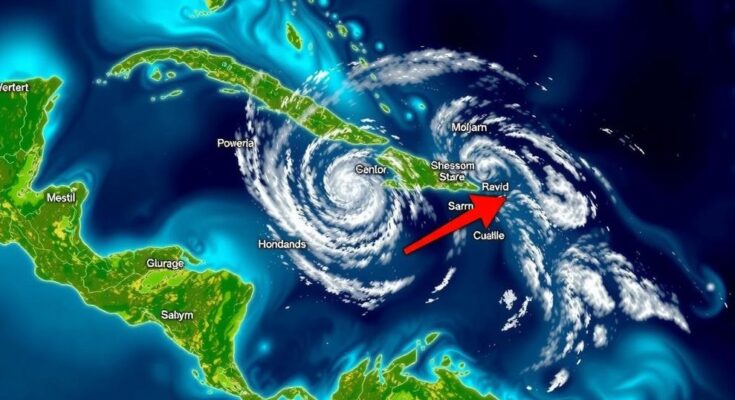Tropical Storm Sara formed in the Western Caribbean, posing a significant flooding threat to northeastern Honduras. This storm marks the 18th named storm of the hyperactive 2024 hurricane season. Historical precedents illustrate severe consequences from hurricanes in Honduras. The storm is expected to weaken as it moves over cooler water but may still cause heavy rainfall prior to landfall.
Tropical Storm Sara developed on November 14, 2024, in the Western Caribbean as an extension of the hyperactive hurricane season, marking 18 named storms including 11 hurricanes. Originating from very warm waters, Sara is projected to impact northeastern Honduras with considerable rainfall, creating a risk for catastrophic flooding. This storm represents a significant precipitation threat, reminiscent of past devastating hurricanes, especially amid Honduras’ historical vulnerabilities to severe tropical weather. Moreover, the storm’s trajectory suggests it may impact the Yucatan Peninsula and Gulf of Mexico, reducing threats to the U.S. Gulf Coast. A notable concern regarding Tropical Storm Sara’s impact is its slow movement near the Honduran coast, which may lead to extreme rainfall, potentially surpassing 20 inches in some areas. Studies indicate that interactions with the mountainous terrain of Honduras could exacerbate flooding and mudslides. Forecasters now predict Sara could transition into a weak tropical cyclone, following a north-northeastward path after impacting the land, which would situate it over cooler sea temperatures and drier air, minimizing any threat to the U.S. Historically, late-season storms have resulted in severe consequences for Honduras. Hurricane Mitch, in 1998, exemplified this by stalling over the country and causing unprecedented losses, with over 11,000 fatalities and devastating floods. More recently, Hurricanes Eta and Iota (2020) inflicted significant damage, displacing millions and crippling economic resources. The United Nations reported that these hurricanes affected nearly 40% of Honduras’ population and resulted in massive financial losses, thereby sparking increased migration to the U.S. due to environmental factors such as these hurricanes.
The importance of the 2024 Atlantic hurricane season cannot be overstated, as it has produced an unusually high number of storms, with Tropical Storm Sara being a latecomer. The warm Caribbean waters have significantly contributed to storm formation, with increased cyclone energy levels indicating a hyperactive season. Recent historical precedents reveal the dire consequences of hurricanes for Honduras, particularly regarding severe flooding and land degradation, which exacerbates socio-economic vulnerabilities and accelerates migration.
In summary, Tropical Storm Sara is a significant development in an already hyperactive hurricane season, threatening to exacerbate vulnerabilities in Honduras with extreme rainfall and flooding risks. The historical context of past hurricanes underscores the potential severity of Sara’s impact, particularly following recent devastating storms that have left a lasting imprint on the region’s resilience and economic stability. The forecast indicates a possible transition of the storm over less favorable conditions for sustaining intensity, potentially alleviating threats to more populated U.S. areas, but the immediate concern remains focused on Honduras.
Original Source: yaleclimateconnections.org




